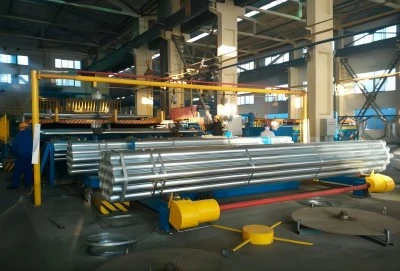Zinc coated pipes are a popular choice in various industries due to their exceptional corrosion resistance and durability. These pipes, also known as galvanized pipes, undergo a protective zinc coating process that significantly extends their lifespan. Commonly used in water supply systems, oil and gas transportation, and structural applications, zinc pipes offer superior protection against rust and corrosion. The zinc coating acts as a sacrificial layer, protecting the underlying steel or iron from environmental factors that could lead to deterioration.
|
|
|
Types of Pipes Commonly Treated with Zinc
Ductile iron pipes: Zinc-sprayed for corrosion control
Ductile iron pipes are widely used in water distribution systems and are often treated with zinc for enhanced corrosion protection. The zinc-spraying process involves applying a thin layer of zinc to the pipe's exterior surface, creating a protective barrier against corrosive elements. This treatment significantly improves the pipe's resistance to soil-based corrosion, particularly in aggressive environments.
The zinc coating on ductile iron pipes typically ranges from 130 to 200 g/m², providing long-lasting protection. This treatment is especially beneficial in areas with high soil acidity or moisture content, where traditional pipe materials might deteriorate rapidly. The zinc layer acts as a sacrificial anode, corroding preferentially to protect the underlying iron, thus extending the pipe's service life considerably.
Steel pipes: Hot-dip galvanized for durability
Steel pipes are often hot-dip galvanized to enhance their durability and corrosion resistance. This process involves immersing the steel pipe in a bath of molten zinc at temperatures around 450°C (842°F). The zinc reacts with the steel surface, forming a metallurgically bonded coating that provides excellent protection against corrosion.
Hot-dip galvanized steel pipes are commonly used in various applications, including water supply systems, fire protection networks, and structural supports. The galvanized coating not only protects the pipe from rust and corrosion but also adds to its aesthetic appeal, giving it a distinctive silver-gray appearance. These pipes are particularly suitable for outdoor installations and in environments where exposure to moisture and corrosive elements is frequent.
ERW and LSAW pipes: Zinc-coated for industrial use
Electric Resistance Welded (ERW) and Longitudinal Submerged Arc Welded (LSAW) pipes are frequently zinc-coated for industrial applications. These pipes are widely used in the oil and gas industry, as well as in large-scale water transportation projects. The zinc coating process for ERW and LSAW pipes can vary depending on the specific requirements of the application.
For ERW pipes, the zinc coating is often applied through a continuous galvanizing process, where the pipe passes through a bath of molten zinc. LSAW pipes, due to their larger sizes, may undergo a spray metallization process or hot-dip galvanizing. The zinc coating on these pipes not only provides corrosion protection but also enhances their resistance to abrasion and weathering, making them ideal for demanding industrial environments.
Benefits of Zinc Coating for Pipe Protection
Extended lifespan: 100+ years vs 50-75 for uncoated pipesOne of the most significant advantages of zinc coating on pipes is the substantial increase in their lifespan. While uncoated pipes typically last between 50 to 75 years, zinc coated pipes can endure for over a century under proper conditions. This extended service life is attributed to the sacrificial protection offered by the zinc layer, which corrodes preferentially to protect the underlying metal.
The longevity of zinc coated pipes translates to reduced maintenance costs and fewer replacements over time. In infrastructure projects, particularly in water distribution systems and underground pipelines, this extended lifespan is crucial. It minimizes disruptions caused by pipe replacements and reduces the overall lifecycle cost of the piping system. The durability of zinc coated pipes also makes them an environmentally friendly choice, as they reduce the need for frequent manufacturing and installation of new pipes.
Cost-effective: Similar overall construction costs
Despite the initial higher cost of zinc coated pipes compared to their uncoated counterparts, they prove to be a cost-effective solution in the long run. The overall construction costs remain similar when factoring in the reduced maintenance and replacement expenses over the pipe's lifetime. The zinc coating acts as a barrier against corrosion, minimizing the need for costly repairs and interventions that are often necessary with unprotected pipes.
In industrial and municipal applications, where downtime can be extremely costly, the reliability of zinc coated pipes offers significant economic benefits. The reduced frequency of pipe failures and leaks leads to lower operational costs and improved system efficiency. Additionally, the extended service life of these pipes means that the initial investment is spread over a much longer period, resulting in a lower annual cost of ownership.
Corrosion resistance: Zinc sacrificial protection
The zinc coating on pipes provides excellent corrosion resistance through a process known as sacrificial protection. When exposed to corrosive elements, the zinc layer corrodes preferentially, protecting the underlying steel or iron. This sacrificial action continues even if the zinc coating is scratched or damaged, as the surrounding zinc will still protect the exposed base metal.
The corrosion resistance of zinc coated pipes is particularly valuable in harsh environments, such as coastal areas with high salt content in the air, or in industrial settings where pipes may be exposed to chemical agents. The zinc coating forms a patina over time, which further enhances its protective properties. This ongoing protection significantly reduces the risk of leaks, bursts, and structural failures that are often associated with corroded pipes, ensuring the integrity and safety of the piping system over its extended lifespan.
Identifying Zinc-Coated Pipes: Visual and Technical Guide
Appearance: Silver-blue hue or white protective coatingzinc coated pipes are easily identifiable by their distinctive appearance. Fresh from the galvanizing process, these pipes exhibit a bright, silvery-blue hue that is characteristic of zinc. Over time, as the zinc coating reacts with the atmosphere, it may develop a slightly duller, grayish appearance. In some cases, particularly with newer galvanizing techniques, the pipes may have a smooth, white protective coating that enhances their corrosion resistance.
The surface texture of zinc coated pipes can vary depending on the application method. Hot-dip galvanized pipes often have a slightly rougher texture with a spangle pattern, while electroplated zinc coatings tend to be smoother. Observing these visual cues can help professionals in the field quickly identify zinc coated pipes, ensuring proper handling and maintenance procedures are followed.
Thickness: 0.2 mils for plating, 1.0 mil for galvanizing
The thickness of the zinc coating is a crucial factor in determining its protective capabilities. Electroplated zinc coatings typically have a thickness of around 0.2 mils (5 microns), while hot-dip galvanized coatings are much thicker, usually around 1.0 mil (25 microns) or more. This thickness difference significantly impacts the longevity and performance of the coating.
Understanding the coating thickness is essential for engineers and project managers when specifying pipes for different applications. Thicker coatings generally provide longer-lasting protection, making them suitable for more demanding environments or applications where maintenance access is limited. The coating thickness can be measured using specialized equipment, allowing for quality control and ensuring that the pipes meet the required specifications for their intended use.
Testing methods: Visual inspection and coating thickness measurement
Several testing methods are employed to verify the quality and thickness of zinc coatings on pipes. Visual inspection is the first step, where experts look for uniformity in the coating, absence of bare spots, and overall surface finish. However, visual inspection alone is not sufficient for a comprehensive assessment.
Coating thickness measurement is typically performed using non-destructive methods such as magnetic thickness gauges or eddy current instruments. These tools provide accurate readings of the zinc layer thickness without damaging the coating. For more detailed analysis, especially in critical applications, destructive tests like cross-sectional microscopy or chemical stripping may be employed. These tests help ensure that the zinc coating meets the required standards and will provide the expected level of protection throughout the pipe's service life.
Zinc coated pipes offer a robust solution for various industrial and infrastructure applications, providing exceptional corrosion resistance and longevity. Their extended lifespan, cost-effectiveness, and superior protection make them an ideal choice for projects ranging from water distribution systems to oil and gas transportation. By understanding the types of zinc-coated pipes, their benefits, and identification methods, professionals can make informed decisions to ensure the durability and efficiency of their piping systems.
Zinc Coated Pipe For Sale
Hebei Longma Group offers high-quality zinc-coated pipes for your industrial and construction needs. Our state-of-the-art production facilities, featuring German-imported equipment and four independently developed production lines, ensure superior product quality. With a professional team of over 300 employees, including 60+ technical experts, we guarantee precision and innovation in every pipe we produce.
Our comprehensive testing facilities, including ultrasonic flaw detectors and industrial X-ray equipment, ensure that each pipe meets the highest standards of quality and durability. We pride ourselves on fast delivery, with standard thickness steel pipes ready in as little as 7 days. Our products are backed by complete certifications, including API 5L, ISO 9001, ISO 14001, and more, meeting international quality standards.
Thanks to our long-term partnerships with raw material suppliers and our integrated production model, we offer competitive pricing without compromising on quality. Our zinc coated pipes, available in various specifications including API 5L, ASTM A53, EN10210, and AS/NZS 1163, with outer diameters ranging from 60.3mm to 1422mm and wall thicknesses from 6.02mm to 50.8mm, are perfect for your project needs. For inquiries or to place an order, contact us at info@longma-group.com.














